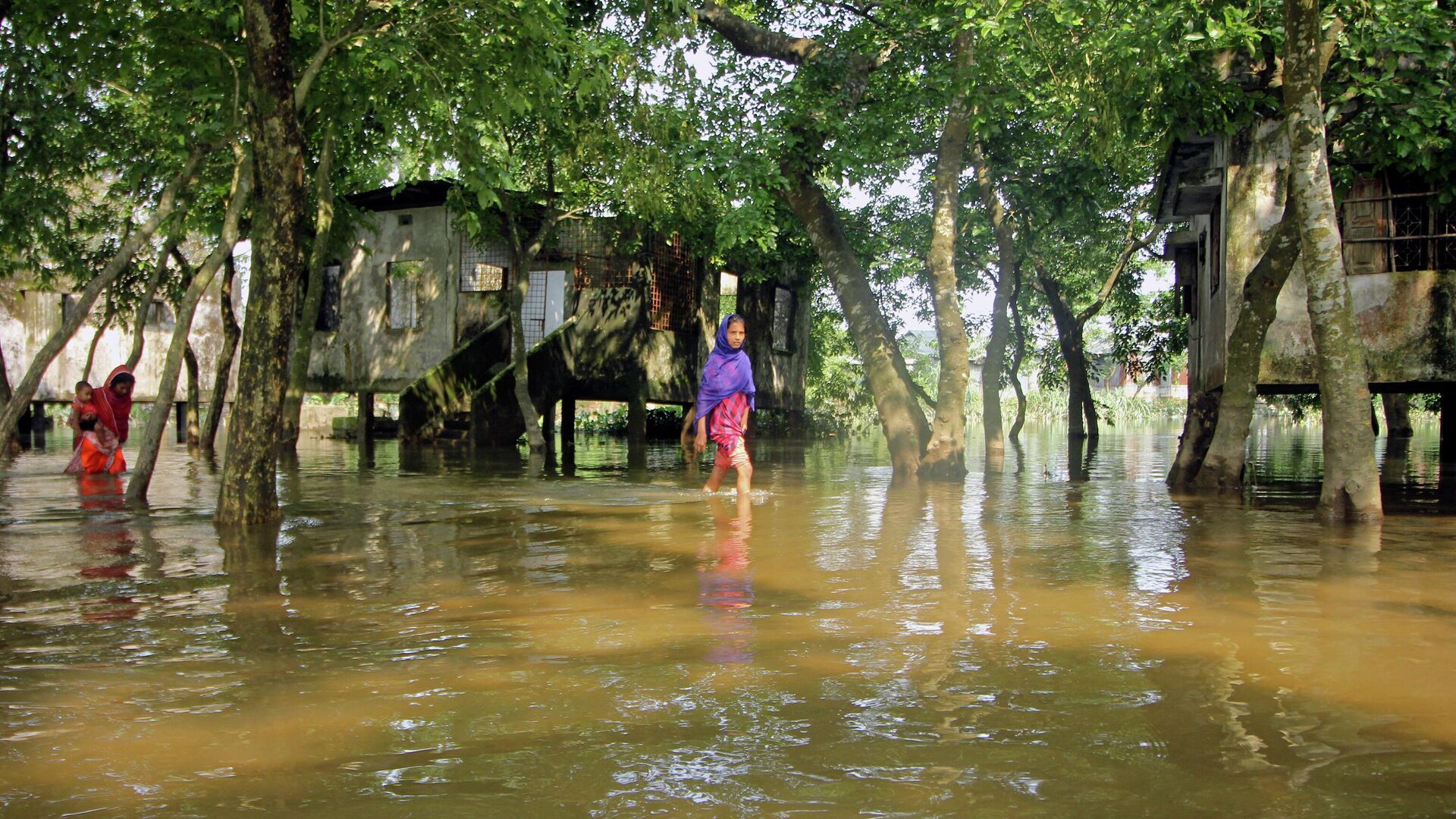https://sputnikglobe.com/20220523/torrential-rains-floods-leave-over-100-dead-in-india-and-bangladesh-1095710332.html
Torrential Rains, Floods Leave Over 100 Dead in India and Bangladesh
Torrential Rains, Floods Leave Over 100 Dead in India and Bangladesh
Sputnik International
According to climate experts, India and Bangladesh are extremely vulnerable to rising temperatures, including more severe monsoon flooding, fierce storms and... 23.05.2022, Sputnik International
2022-05-23T10:53+0000
2022-05-23T10:53+0000
2023-02-14T08:48+0000
bangladesh
rain
torrential rains
rain
rain
state of assam
floods
https://cdn1.img.sputnikglobe.com/img/07e6/05/17/1095712800_0:83:3072:1811_1920x0_80_0_0_c72247a0c3ae4bc60beacc2f28540028.jpg
At least 60 people have died in Bangladesh and 57 in neighbouring India after incessant pre-monsoon rains severely hit northeast Bangladesh and the Indian states of Assam and Bihar over the last fortnight, a media report said. In Bangladesh alone, according to AFP, at least two million people have been affected, especially in the northeastern part of the country which has witnessed the worst floods in nearly 20 years.In northeast India's Assam, the death toll reached 24 on Sunday, the State's Disaster Management Authority stated. Over 700,000 people have been reportedly affected due to the floods, caused by torrential rains that have left more than 1,500 villages inundated.The state authority has set up as many as 421 relief (material) distribution centres in the state, which were also providing rehabilitation to around 100,000 people as of Sunday. The state is also air-dropping food to flood-affected areas. Dima Hasao District remains completely cut off and authorities have prioritised trying to reach the area, Assam State Chief Himanta Biswa Sarma said. The meteorological department has forecast that floodwaters will start receding starting Monday in Assam state in India, and Bangladesh. For the past two weeks, torrential rainfall and landslides have devastated Assam. Traffic has been affected as the water has inundated roads, railway tracks, and the airport.In India's Bihar state, 33 people died amid lightning and thunderstorms on Friday. State Chief Nitish Kumar announced that the families of those killed would receive compensation. Barely a week earlier, the state had witnessed an intense heatwave, with temperatures reaching 40 degrees Celsius (104 degrees Fahrenheit). Meanwhile, according to a study published by the Indian Institute of Tropical Meteorology in January, India and Bangladesh are vulnerable to climate change because of their proximity to the warm tropical waters of the Indian Ocean and the Bay of Bengal, which is increasingly experiencing heat waves.Every extra degree of global warming increases the amount of water in the atmosphere by about 7 percent, which has inevitable effects on rainfall.
bangladesh
state of assam
Sputnik International
feedback@sputniknews.com
+74956456601
MIA „Rossiya Segodnya“
2022
Deexa Khanduri
https://cdn1.img.sputnikglobe.com/img/07e4/0c/1e/1081607388_0:0:961:960_100x100_80_0_0_e9e931b8c1e18fb41f3074e2145d7a3a.jpg
Deexa Khanduri
https://cdn1.img.sputnikglobe.com/img/07e4/0c/1e/1081607388_0:0:961:960_100x100_80_0_0_e9e931b8c1e18fb41f3074e2145d7a3a.jpg
News
en_EN
Sputnik International
feedback@sputniknews.com
+74956456601
MIA „Rossiya Segodnya“
Sputnik International
feedback@sputniknews.com
+74956456601
MIA „Rossiya Segodnya“
Deexa Khanduri
https://cdn1.img.sputnikglobe.com/img/07e4/0c/1e/1081607388_0:0:961:960_100x100_80_0_0_e9e931b8c1e18fb41f3074e2145d7a3a.jpg
bangladesh, rain, torrential rains, rain, rain, state of assam, floods
bangladesh, rain, torrential rains, rain, rain, state of assam, floods
Torrential Rains, Floods Leave Over 100 Dead in India and Bangladesh
10:53 GMT 23.05.2022 (Updated: 08:48 GMT 14.02.2023) Deexa Khanduri
Sputnik correspondent
According to climate experts, India and Bangladesh are extremely vulnerable to rising temperatures, including more severe monsoon flooding, fierce storms and higher sea levels.
At least 60 people have died in Bangladesh and 57 in neighbouring India after incessant pre-monsoon rains severely hit northeast Bangladesh and the
Indian states of Assam and Bihar over the last fortnight, a media report said.
In Bangladesh alone, according to AFP, at least two million people have been affected, especially in the
northeastern part of the country which has witnessed the worst floods in nearly 20 years.
In northeast India's Assam, the death toll reached 24 on Sunday, the State's Disaster Management Authority stated.
Over 700,000 people have been reportedly affected due to the floods, caused by torrential rains that have left more than 1,500 villages inundated.
The state authority has set up as many as 421 relief (material) distribution centres in the state, which were also providing rehabilitation to around 100,000 people as of Sunday.
The state is also air-dropping food to flood-affected areas.
Dima Hasao District remains completely cut off and authorities have prioritised trying to reach the area, Assam State Chief Himanta Biswa Sarma said.
The meteorological department has forecast that floodwaters will start receding starting Monday in Assam state in India, and Bangladesh.
For the past two weeks, torrential rainfall and landslides have devastated Assam. Traffic has been affected as the water has inundated roads, railway tracks, and the airport.
In India's Bihar state, 33 people died amid lightning and thunderstorms on Friday. State Chief Nitish Kumar announced that the families of those killed would receive compensation.
Barely a week earlier, the state had witnessed an intense heatwave, with temperatures reaching
40 degrees Celsius (104 degrees Fahrenheit).
Meanwhile, according to a study published by the Indian Institute of Tropical Meteorology in January, India and Bangladesh are vulnerable to climate change because of their proximity to the warm tropical waters of the Indian Ocean and the Bay of Bengal, which is increasingly experiencing heat waves.
Every extra degree of global warming increases the amount of water in the atmosphere by about 7 percent, which has inevitable effects on rainfall.


